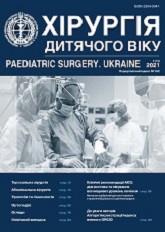Peculiarities of feminizing surgical correction in children with disorders of sexual development
DOI:
https://doi.org/10.15574/PS.2021.72.63Keywords:
disorders of sexual development (DSD), hermaphroditism, feminizing correctionAbstract
Purpose – to analyze own results of surgical treatment of serious forms of disorders of sexual development (DSD) in children after feminizing surgeries. To define practical protocol guides on the choice of the type of surgical correction.
Materials and methods. Over the past 5 years surgeons of Lviv regional paediatric clinical hospital «OHMATDYT» have examined 12 children with DSD, signs of hermaphroditism (intersex). After complex examination the following states were diagnosed: androgenital syndrome in 5 girls (referred for further treatment to Kyiv paediatric medical centres); true hermaphroditism – 1 child; mixed gonadal dysgenesis (MCG) – 3 children; female pseudohermaphroditism (without determining genesis) – 1 child; partial testicular feminization syndrome, Morris syndrome (male pseudohermaphroditism) – 2 children. In connection with marked masculinization of external genitalia two children with MCG and the girl with pseudohermaphroditism underwent feminizing surgery, namely genital zone reconstruction, mobilization and excision of urogenital sinus walls, excision of genital cavernous bodies (in children with MCG) with clitoroplasty, vulvoplasty with labioplasty and vaginoplasty. Children with Morris syndrome are being prepared to feminizing surgery.
Results. Each child had a personal examination plan. Verification of a child’s state lasted from several weeks to 2–3 months. Children who underwent feminizing surgery did not have male structures and had relatively well-developed female structures. More «natural», less traumatizing correction was preformed for each specific case. In all children who underwent surgery vagina opened into urogenital sinus lower than external urethral sphincter, so there was no need to form front vagina wall (back and side walls were formed). Out of all children treated in our hospital gender was legally changed to the opposite.
Conclusions. The birth of a child with DSD is a most challenging problem for parents, doctors, psychologists and social workers. Such states require complex examination. Children with severe hypospadias must undergo genetic examination. Statistic data and our own experience show higher frequency of feminizing surgeries in such cases. The most difficult part of such surgeries proves to be the excision of genital cavernous bodies with clitoroplasty and clitoris translocation; the most responsible part in functional sense is vaginoplasty. Surgical treatment is not the final stage of treatment for such patients. Children with DSD require constant further dynamic checkups by gynaecologists, urologists, oncologists, endocrinologists, psychologists with relevant therapy correction.
The research was carried out in accordance with the principles of the Helsinki declaration. The study protocol was approved by the Local ethics committee of all participating institution. The informed consent of the patient was obtained for conducting the studies.
No conflict of interest was declared by the authors.
References
AbouZeid Amr Abdelhamid. (2020). Feminizing genitoplasty in childhood: aiming for achievable outcomes. Springer. Annals of Pediatric Surgery. 16 (1): 34. https://doi.org/10.1186/s43159-020-00044-w
Conn J, Gillam L, Conway G. (2005). Revealing the diagnosis of androgen insensitivity syndrome in adulthood. BMJ. https://doi.org/10.1136/bmj.331.7517.628; PMid:16166136
Dreger AD, Chase C, Sousa A, Grupposo PA, Frader J. (2005). Changing the nomenclature/taxonomy for intersex: a scientific and clinical rationale. J Pediatr Endocrinol Metab. https://doi.org/10.1515/JPEM.2005.18.8.729; PMid:16200837
Hindmarsh PC, Geertsma K. (2017, April). Congenital Adrenal Hyperplasia. Academic Press. https://doi.org/10.1016/B978-0-12-811483-4.00003-9
Lee PA, Houk CP, Faisal SA, Hughes IA. (2006, Aug). In collaboration with the participants in the International Consensus Conference on Intersex organized by the Lawson Wilkins Pediatric Endocrine Society and the European Society for Paediatric Endocrinology Pediatrics. Consensus Statement on Management of Intersex Disorders. https://doi.org/10.1542/peds.2006-0738; PMid:16882788
Ramani P, Yeung CK, Habeebu SS. (1993). Testicular intratubular germ cell neoplasia in children and adults with intersex. Am J Surg Pathol. https://doi.org/10.1097/00000478-199311000-00005
Waterloos M, Claeys T, Sempels M, Van Laecke E, Hoebeke P, Spinoit AF. (2018, Apr). Genitoplasty in newborn females with adrenogenital syndrome: Focus on the reconstruction technique and its outcomes. J Pediatr Urol: 14. https://doi.org/10.1016/j.jpurol.2018.02.011; PMid:29551555
Wisniewski AB, Migeon CJ, Meyer-Bahlburg HF et al. (2000). Complete androgen insensitivity syndrome: long-term medical, surgical, and psychosexual outcome. J Clin Endocrinol Metab. https://doi.org/10.1210/jc.85.8.2664; PMid:10946863
Downloads
Published
Issue
Section
License
The policy of the Journal “PAEDIATRIC SURGERY. UKRAINE” is compatible with the vast majority of funders' of open access and self-archiving policies. The journal provides immediate open access route being convinced that everyone – not only scientists - can benefit from research results, and publishes articles exclusively under open access distribution, with a Creative Commons Attribution-Noncommercial 4.0 international license(СС BY-NC).
Authors transfer the copyright to the Journal “PAEDIATRIC SURGERY.UKRAINE” when the manuscript is accepted for publication. Authors declare that this manuscript has not been published nor is under simultaneous consideration for publication elsewhere. After publication, the articles become freely available on-line to the public.
Readers have the right to use, distribute, and reproduce articles in any medium, provided the articles and the journal are properly cited.
The use of published materials for commercial purposes is strongly prohibited.

